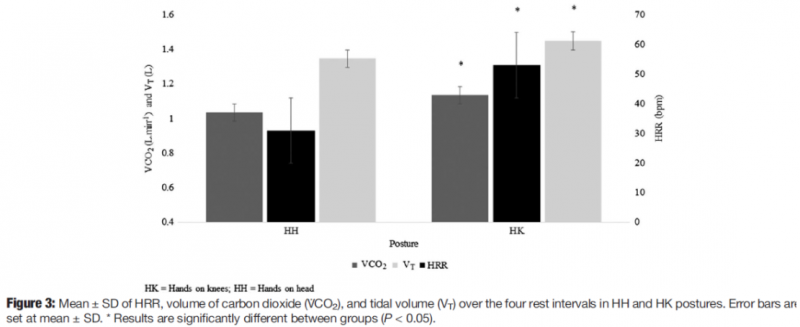
For about 24 hours, or so it seemed, the world of S&C was so taken aback by something that they weren't talking about politics, constitutional law, or COVID-19.
An article came out about different hand positions for recovery.
When I saw the article, I thought, "Yeah, it makes sense." I've thought that for a few years, as a result of teaching anatomy. For many S&C coaches, we have never wanted to show a sign of weakness—a proverbial kink in the armor of our athletes that we developed. We want our athletes to be superior to their competition on game day and attempt to make sure that this is not only true but can be perceived as invincible by the opposition. When an athlete bent over, it showed who was weak, and we didn't want to have our athletes appearing weak, so we made them stand up. We trained them to stand up not to show weakness. A common statement coaches said was, "There is no air down there, stand up." Just examining the environment shows that this is wrong unless by "down there," you are breathing into and out of a paper bag, which will raise CO2 levels. Back to the point. So a study came out and said, "Hey, you know what? If you want recovery, you should put your hands on your knees." So, of course, as this goes against what we have been taught, this sent many people into an uproar. In this article, we'll talk about what the study found exactly and take a moment to see as to why. We won't make any statements about which way is right because that is a decision that has to be made by you.
RECENT: Division Differences in Jumping Ability
This study used 24 Division II female soccer players who were participating in their off-season conditioning program. They all performed the same training intervention on two separate days, which was a typical 4x4 workout while hooked up to a metabolic cart. For those who are not familiar, this is a common conditioning workout in soccer where the athlete will run continuously for 4 minutes at 90-95% of their maximum heart rate with a 3-minute passive recovery. Passive recovery is defined as not performing any form of active rest (walking, jogging, etc.). The metabolic cart measured their gas exchange to see what was occurring during both exercise and rest from a metabolic lens. The volume of carbon dioxide exhaled, and tidal volume was examined. During the passive recovery is when the rest intervention was employed, and the subjects were either instructed to stay standing upright with their hands on their head (labeled as HH) or bent over with their hands on their knees (HK).
I have taken figure 3 from their article, which visualized the differences and is included below. VCO2 is the volume of carbon dioxide exhaled. CO2 is a by-product of the Krebs cycle (used to break down substrate to get energy in the aerobic energy system), so blowing it off indicates greater use of that system, which is the system that will help to facilitate recovery between work bouts. The tidal volume is simply how much air is being taken in per breath, which is an indicator of fitness. HRR is heart rate recovery, so the greater the number here indicates how many beats per minute decrease were seen in the 3-minute passive recovery. The greater the heart rate recovery, the more recovered the person will be for their next bout of exercise. As stated in the figure legend, the asterisk (*) shows a significant difference between the two groups.
So what does figure 3 tell us? Well, the HK group did a better job of blowing off CO2, used more air, which most likely facilitated a greater heart rate recovery. Blowing off the greater amounts of CO2 also would allow the blood pH to remain closer to its normal levels. This will be important because that will allow for more utilization of the immediate energy system as well as fast and slow glycolysis during the next set, allowing for a greater workload to be performed. In essence, the athlete will be able to move faster and go harder for the next bout. The inability to get the greater inhalation of air for the HH group most likely led to the heart rate remaining elevated as the athletes had to keep the heart rate higher to get in enough oxygen—to continue with the regular metabolic processes as CO2 is a signaling agent to increase activity of the slower energy systems and inhibit activity of the faster-acting systems.
Many people will be quick to point out, "Yes, it was significant. That's great. You can have a significant difference and be meaningless." That is ABSOLUTELY true. To account for this, the authors examined the effect size, which is essentially telling us how big of an impact did this have. The effect sizes were medium (cohen's d for both were 0.5) for total ventilation and VCO2. This is definitely a difference that is worth looking at. HOWEVER, the effect size was very large (d=1.98) for heart rate recovery, which showed a 22 bpm difference between the two groups. Now, if we just look at the typical 220- age for an age predicted heart rate max, we can see that the average max heart rate would be 199.7, so 200bpm is maximal. We are looking at a difference in 11 percent of max heart rate between the groups based off of resting posture.
In order to provide some context, let's do some math. The heart rate recovery (HRR) was 53bpm for the HK group and 31 for the HH group. Knowing that the athletes were supposed to run at 90-95 percent of max heart rate, they would finish the session at 180-190bpm. To keep everything even, we will just go with 180bpm. When starting the subsequent bout of exercise, the HH group started at 149bpm or 74.5 percent of their max heart rate, where the HK group started at 127bpm, or 63.5 percent of their max heart rate. It would seem then, that the HK group would be able to start at a higher velocity than the HH group and get a greater training distance in for the conditioning session for the same impact on the cardiovascular system.
MORE: What We Can Do As S&C Coaches
Now, why on earth would putting your hands on your head vs. your knees make such a great difference? It's just hand position, right? The authors mentioned that bending over and placing your hands on your knees internally rotated the rib cage and optimized zone of apposition, which allowed for the diaphragm and other muscles of inhalation to have better lines of pull for increased expansion of the rib cage and thus inhalation. If there is a greater inhalation response, then of course, you will be forced to expire more air and CO2. In essence, you are not using as much energy to inhale and exhale, which allows you to recover better.
Conversely, when you place your hands over your head, you are elevating and expanding the rib cage. When the diaphragm attempts to pull down to get more oxygen in, it is facing greater resistance and isn't able to pull down due to the muscles' already being in what is called active insufficiency—the muscles are so shortened that their cross bridge linkage is blocked by the other actin and now can not get an active binding site. The subjects in this study, who were healthy, showed signs of dyspnea or difficulty getting in a breath when their hands were over their head.
Something interesting to me in this study was the angle of inclination of the torso. Each set, the subjects were leaning over more and more, which seems to be allowing for an increased ease of expansion of the rib cage. The more you lean over, the more you will utilize gravity to expand the rib cage while keeping the diaphragm and the musculature of inhalation in an optimal length for inhalation. If you can get gravity to help you, it seems that the musculature will be able to focus more on breathing and less on keeping you upright.
One aspect of performance that wasn't reported in this study, and I hope we see a subsequent study coming out from them on this, is what happened in the subsequent work bout? It would seem that if you are more recovered, you can travel a greater distance in the subsequent set. While the heart rate was controlled for, distance and speed were dependent upon the heart rate. Were the more recovered athletes able to run a greater distance in the subsequent set? If so, then fantastic. If not, then maybe recovery isn't as important as we think.
I only caught bits and pieces of "The Last Dance" as I have two kids that are four and under while teaching multiple classes and changing everything up due to COVID-19. One thing that I seem to remember from the show is that the length of the shorts increased during his tenure in the NBA. He liked having a longer and baggier short because it was easier to rest your hands on your knees when you had the opportunity. This bit of intuition may have led him to be able to recover better during whatever rest intervals he could get during practice and games.
Now, what does this mean for the argument of someone not bending over to rest? Well, nothing and everything. It is completely valid that if someone leans over, that is an indication that they are tired. If someone is more tired, it may indicate to the other team to try and exploit this person. There is something to be said for the psychological aspect over your opponent when you see them caving. If you lock up on an opponent and just completely dominate them as they aren't able to recover by the third or fourth play in a football game, you're telling your coach what is going on—to run right behind you as you are going to blow his doors off. But what about the flip side? I can imagine seeing my opponent bending over, leading me to think I am going to go in for total domination of him, then when I lock up on him, I feel an intense battle, it may be demoralizing.
Of course, there is another level to this. If someone is in great condition and can go for a long time without getting tired, this is a moot point. There is an old saying that fatigue makes a coward out of a lion. If you are in good enough shape to play the game and not get tired, then that is fantastic, and you're going to win a lot of games if your athletes have a good talent level. I also want to point out that maintaining a high level of play rather than just not getting tired. If you are a super slow and fatigue resistant, you probably aren't going to win a sport of high speed and explosive activities.
The bottom line is, coaching is an art. It is how you weave everything in together. You need to have good information to make the best decisions. I remember hearing my coaches yelling at me that there is no air down there when you bend over. It was repeated in my early coaching career (pre about 2011). Well, this simply wasn't true. Air is a gas and is everywhere. Provided you're not breathing into a bag, you will have the same access to air in any position, and it may help you recover better for the next bout. So, I was making a poor statement. If you stand on showing no signs of weakness, then the hands on head (or even hips, although this wasn't examined) makes the most sense. If you stand on being the best recovered, it appears letting them lean over and put their hands on their knees is best. It is your job to be able to pull all of the information together to shape your coaching paradigm.
Reference
Michaelson, Joana V., et al. "Effects of Two Different Recovery Postures during High-Intensity Interval Training." Translational Journal of the American College of Sports Medicine 4.4 (2019): 23-27.












4 Comments